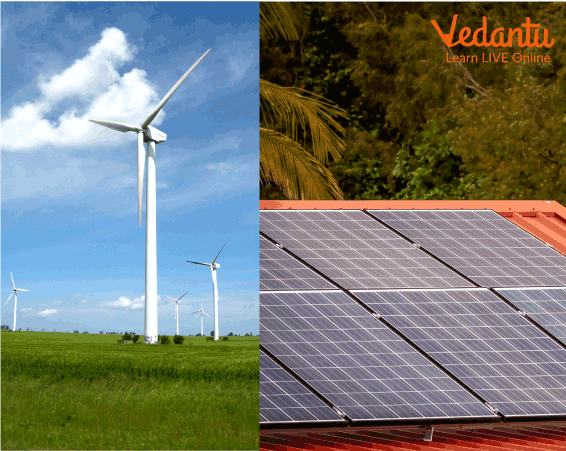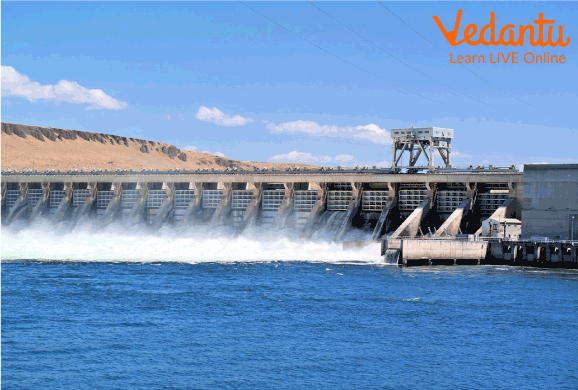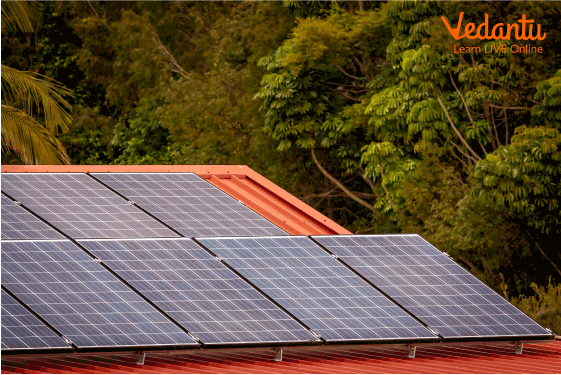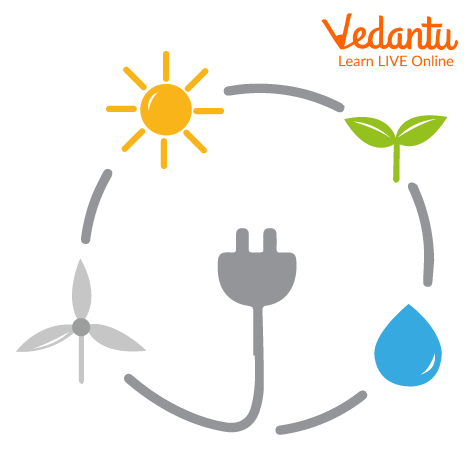




Introduction
We can get energy from various natural sources, which can be modified into forms that humans can easily use for their benefit. These energy resources are available in two forms: renewable and non-renewable energy. Renewable energy is a form of energy that gets renewed after a short period, whereas non-renewable energy does not get renewed and may get exhausted after a particular period.
What is Renewable Energy?
Renewable energy for kids is the form of energy that gets renewed or is present in an abundant form. This form of energy is usually taken from natural resources. They do not produce greenhouse gasses and are a greener and more sustainable option for the Earth. Renewable resources are cost-effective or cheap when compared to non-renewable sources of energy. Some renewable resources examples are the sun, wind, and water.

Wind Turbines and Solar Panels
Types of Renewable Energy
The various sources through which renewable energy can be obtained are the sun, water, wind, heat, and organic material. These sources are modified in a form that can be used by humans easily. Some renewable energy sources examples are given below.
Solar Energy is the most widely used form of energy extracted from the sunlight present during the day. Using technology, the sunlight is changed into electricity which humans can use. Solar panels are used to absorb sunlight. They can absorb sunlight even on cloudy days. These solar panels can be used for about 25-30 years.
Wind Energy can be extracted from the wind using wind turbines. Not all places on Earth are fit for the installation of wind turbines due to the irregular flow of wind. Wind farms are a fantastic way to use sustainable energy, but they must be carefully planned. The primary environmental drawback is that they might disrupt animal migratory patterns.
Hydro Energy is generated by water. Dams are built to harvest energy from water. Hydropower reservoirs frequently provide numerous functions, including drinking water, irrigation water, flood and drought management, and electricity delivery. Hydropower is now the most important renewable energy source in the electrical industry.

Hydropower Generated Through the Dam
Other Resources- The heat generated by the Earth is used to produce electricity by geothermal energy, and energy produced by the plant material along with other biodegradable products is called bioenergy.

Solar Panels
Advantages of Renewable Energy
Clean, secure, and efficient.
There are several techniques for producing renewable energy.
Provides countries with energy independence.
It creates jobs in your neighborhood.
It is not dependent on the main power grid.
Cost-effective.
Environment-friendly.
Electricity is generated at a cheaper cost.
Disadvantages of Renewable Energy
The energy produced cannot be stored.
The setup of the devices is costly.
A large land area is required.
Fun Facts
Solar and wind power is the growing form of renewable energy.
For one year, one wind turbine can power up to 1,500 houses.
In 2021, renewable energy sources produced 38% of global electricity.
Renewable energy accounts for 98.4% of Norway's energy consumption.
If you could capture all of the sunlight that falls on Earth in one hour, you would have enough energy to power the planet for a year.

Renewable Energy Sources
Sample Questions
1. Renewable form of energy does not include
a) Sun
b) Wind
c) Fossil
d) Plant
Ans: Fossil
Explanation: Fossils are made from the dead remains of plants and animals. They get covered by the layers of soil, and the pressure and heat present inside the Earth change them into fossil fuels like petroleum. These forms of energy are very limited and cannot be renewed.
2. Which renewable energy source generates power using rivers or the ocean?
a) Solar energy
b) Wind energy
c) Hydropower
d) Geothermal energy
Ans: Hydropower
Explanation: Solar energy uses the sun as the energy source whereas, wind and geothermal energy use wind and heat generated from Earth as their energy source respectively.
3. Which of the following characterizes renewable energy the best?
a) Energy derived from fossil fuels
b) Energy produced by the burning of something
c) An energy source derived from the sun, wind, and water.
d) All of the above
Ans. An energy source derived from the sun, wind, and water.
Explanation: Renewable energy sources are those energy sources that will not get depleted or finished and are present in nature in large quantities.
Conclusion
In this article we have studied renewable energy. These are the sources of energy that are renewable. They usually exist in the natural world. When asked "what are renewable energy sources," we might respond, "a renewable source is a natural resource that refills the depleted or used amount of resource within a finite time interval on the human time scale, either through natural reproduction or through recurrent processes." Major renewable resources include solar, wind, biomass, and geothermal.
FAQs on Renewable Energy for Kids
1. What is renewable energy in simple words for kids?
Renewable energy is a type of clean energy that comes from natural sources that never run out. Think of it like a magic pot of porridge that keeps refilling itself! These sources, like the sun and wind, are constantly available and are much better for our planet than energy sources that can be used up.
2. What are the main examples of renewable energy sources?
The most common types of renewable energy sources are easy to find in nature. The main examples include:
Solar Energy: Power from the sun's rays.
Wind Energy: Power from the movement of wind.
Hydropower: Energy from moving water, like rivers or waterfalls.
Geothermal Energy: Heat from the inside of the Earth.
Bioenergy: Energy made from natural things like plants and wood.
3. How is renewable energy different from non-renewable energy?
The main difference is that renewable energy sources replenish themselves naturally, so we can't run out of them. For example, the sun will shine and the wind will blow tomorrow. Non-renewable energy sources, like coal and oil, are finite. This means that once we use them all up, they are gone forever because they take millions of years to form.
4. Why is using renewable energy so important for our Earth?
Using renewable energy is very important because it is clean energy. When we use non-renewable fuels like coal, they release harmful gases called greenhouse gases, which pollute the air and warm the planet. Renewable energy sources like solar and wind power create electricity without making this pollution, helping to keep our planet healthy for everyone.
5. How do solar panels create electricity from sunlight?
Solar panels, which you might see on rooftops, work like special collectors. They are made of materials that can catch the sunlight and turn its energy directly into electricity. This electricity can then be used to power lights, televisions, and other things in our homes. It's a way of using the sun's free and powerful energy.
6. What is geothermal energy?
Geothermal energy is heat that comes from the very hot centre of the Earth. Deep underground, there are hot rocks and pockets of steam. We can use this natural heat to warm up water, which then creates steam to spin turbines and generate electricity. It's like using the Earth's own natural furnace for power.
7. If the sun doesn't shine at night, how do we get solar power?
That's a great question! During the day, solar panels can produce more electricity than a house needs. This extra energy isn't wasted; it can be stored in large batteries. Then, at night or on a cloudy day, the house can use the electricity saved in these batteries to keep the lights on.
8. What is bioenergy?
Bioenergy is a type of renewable energy that comes from biomass, which is any organic material like plants, wood chips, or even leftover food. When this material is burned or processed, it releases energy that can be converted into heat or electricity. It's a way of recycling natural materials for power.









